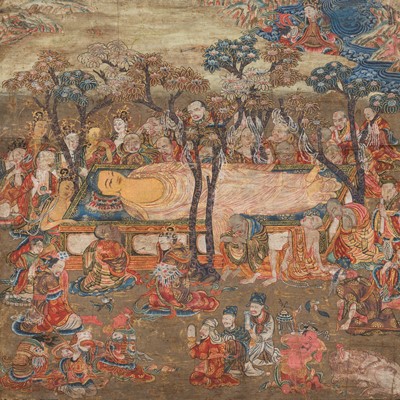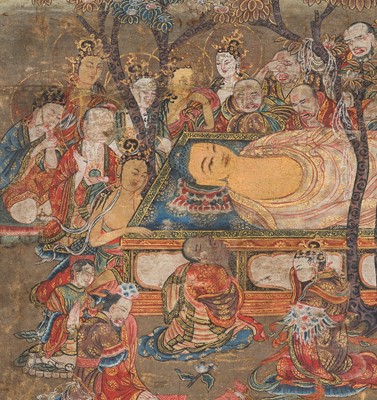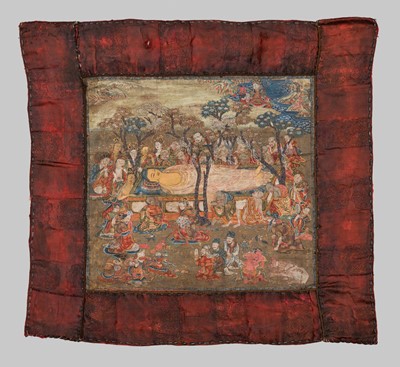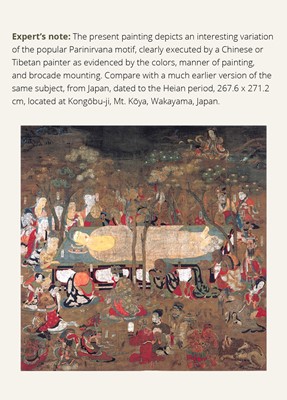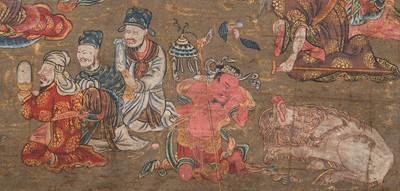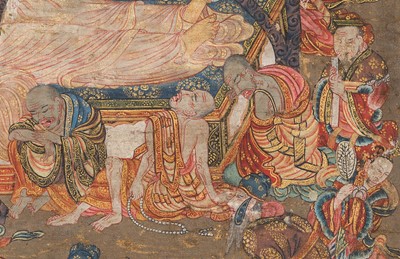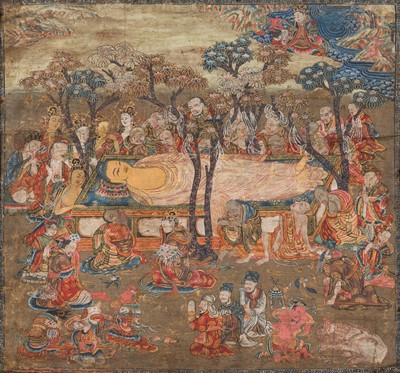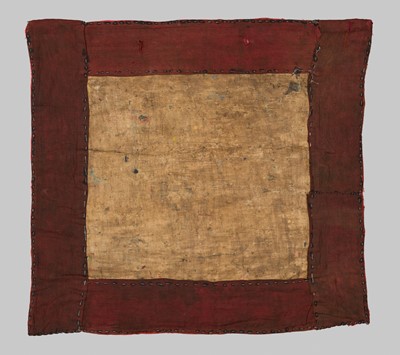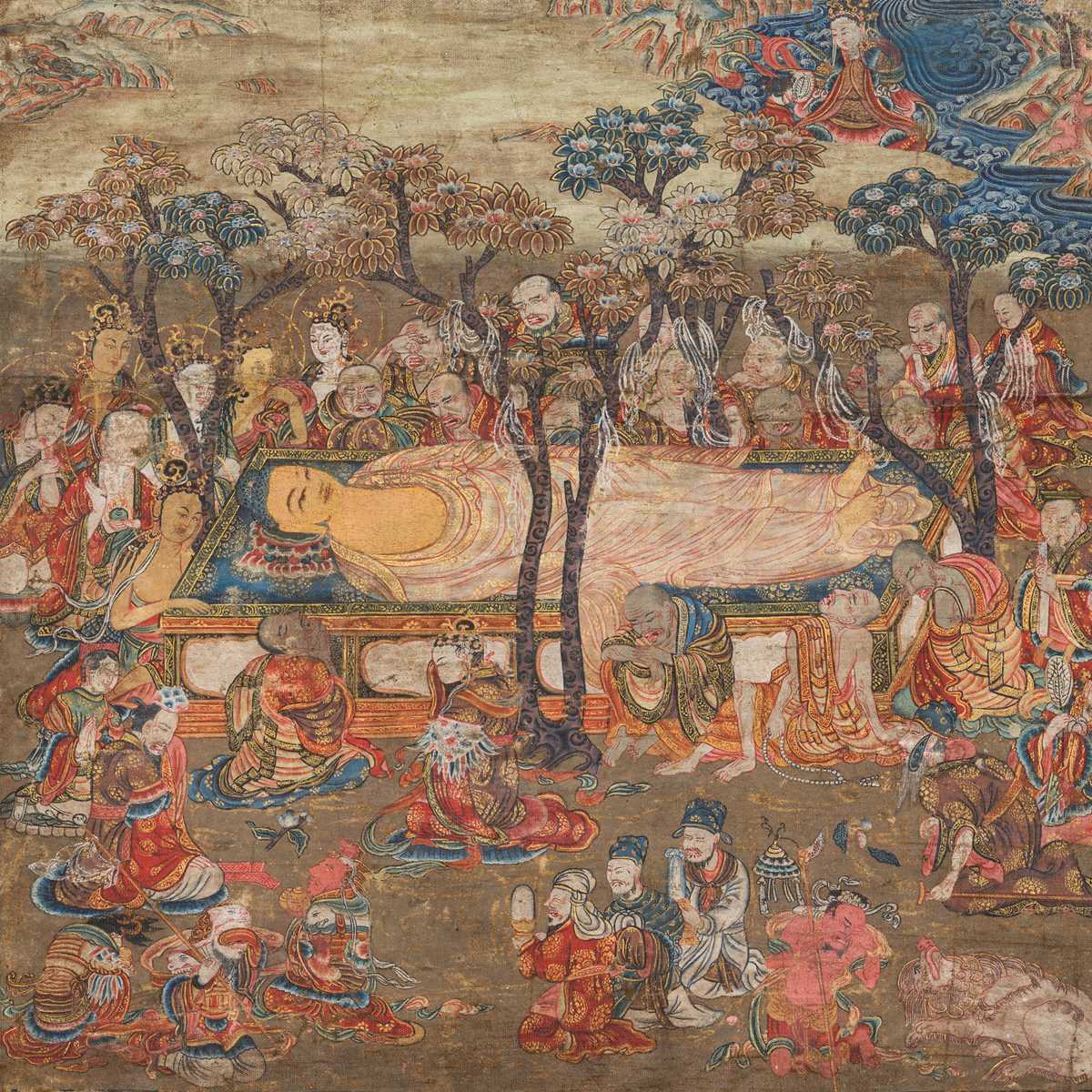Until 2nd Apr, 2025
Buy it now
A PAINTING DEPICTING THE BUDDHA’S PARINIRVANA, QING DYNASTY
LOT 26 - FAS0424
Tibetan-Chinese, 18th-19th century. Distemper and gold on cloth. Lying on a raised bed surrounded by a crowd of mourners consisting of celestial beings, bodhisattva, dignitaries and animals lamenting his death. Buddha’s expression is peaceful and serene, his arms slack to his side, his head resting on a pillow. Young magnolia trees shade the buddha with their multi-colored leaves bearing blossoms. The uppermost register depicts a blue and red celestial landscape with a single deity above a river valley. All enclosed with a blue floral border mounted on a silk frame.
Provenance: Koller, Zurich, 29 November 2022, lot 179, estimated at CHF 10,000 – CHF 15,000 or approx. EUR 11,500 – 17,250 converted and adjusted for inflation at the time of writing.
Condition: Good condition with wear, minor soiling, light fading, creasing, and minor losses to gilding. The silk brocade in fair condition with extensive wear, soiling, loose threads, and small tears.
Dimensions: Image size 30.6 x 32.6 cm, Size incl. frame 46 x 49 cm
The death of the Buddha, also known as the Buddha’s Parinirvana referring to the Buddha’s enlightenment after death, has been depicted widely in Buddhist iconography and is recounted in the Mahaparinirvana sutra. According to Buddhist tradition, the Buddha died in Kushinagara, Northern India, with the traditional dates of Buddha's life from 566-486 BC. After his death, the Buddha’s body was cremated and distributed among his followers. The stupas that guarded his remains became important pilgrimage sites for Buddhists.
The Mahaparinirvana sutra is one of the most important Buddhist scriptures, and it relates the events surrounding the Buddha’s death. The precise date of origin of this text is uncertain, but its early form may have developed in or by the second century CE. The original Sanskrit text is not extant except for a small number of fragments, but it survives in Chinese and Tibetan translation.
Expert’s note: The present painting depicts an interesting variation of the popular Parinirvana motif, clearly executed by a Chinese or Tibetan painter as evidenced by the colors, manner of painting, and brocade mounting. Compare with a much earlier version of the same subject, from Japan, dated to the Heian period, 267.6 x 271.2 cm, located at Kongōbu-ji, Mt. Kōya, Wakayama, Japan.
Natural Light Images for Logged-in Users Only
You can find images of this item taken under natural daylight below. Click on an image to zoom in or save.
If there are no natural light images for this item, please email us at office@zacke.at or use the request form below.
Log in or sign up to view the natural light images.
Click here to request more information on this lot.
How to Buy Online
You must log in or create an online account in order to buy items from the shop.
Click the red 'Buy it Now' button to buy this item. You will then be able to download your invoice and receive instructions about how to pay. Prices include Buyer's Premium.
If you would like to buy multiple items at the same time, add the items you want to your cart. You will then be able to check out with multiple items simultaneously.
Items in your cart are not reserved. Please complete the purchase process promptly to secure the items.
How to Buy Offline
If you would like to buy one of these items outside of the online shop, please contact us at office@zacke.at or +43 (1) 532 04 52.
Our Terms and Conditions
As part of our ongoing efforts to keep our auctions fair and transparent, we encourage you to read our terms and conditions thoroughly. We urge you to read through §34-50) to ensure you understand them. These terms are specifically designed to protect all serious and committed buyers from bidding against non-payers who attempt to inflate prices without the intent of paying their auction bills.
For further reading about non-payers at auction, go here: https://www.zacke.at/aboutnonpayers/.
The main points include the following:
- Bidders must complete their due diligence and clarify all questions about the objects before the auction. After the auction, Zacke will not answer questions from bidders unless the purchase price has been paid in full. Of course, this does not apply to questions concerning shipping, insurance, customs, etc.
- A sale cancellation of any kind after the fall of the hammer is not possible. The only exception to this fundamental rule is our guarantee of authenticity [the Guarantee].
- A Guarantee Claim, however, can only be raised after the purchase price has been paid in full by the buyer and within 45 days after the auction day.
If you have any questions about our policies, please get in touch with us at office@zacke.at.
By placing a bid, you agree to our Terms of Auction and Terms and Conditions.
